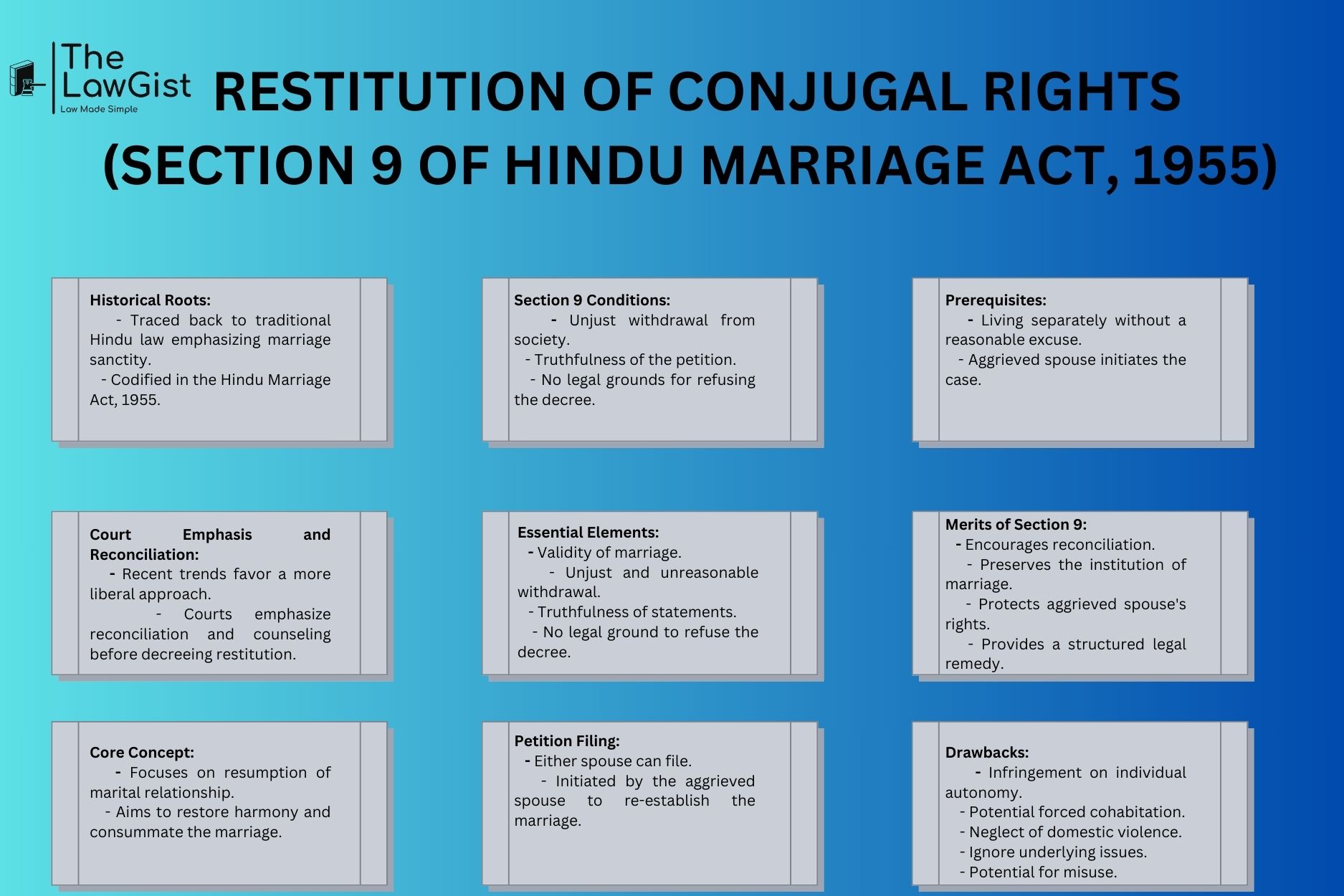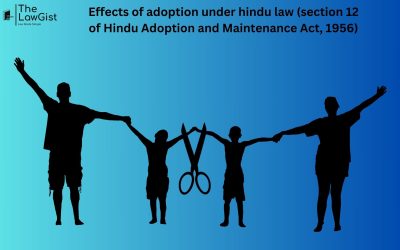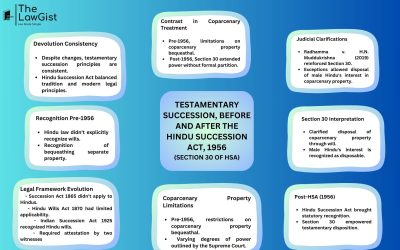INTRODUCTION
Section 9 of the Hindu Marriage Act, 1955, delves into the intricate realm of Restitution Of Conjugal Rights. This legal provision empowers an aggrieved spouse to seek court intervention when the other has withdrawn from the marital union without a reasonable excuse. While aiming to preserve the sanctity of marriage, Section 9 has been both applauded for its intent and criticized for its potential infringement on individual rights. This analysis scrutinizes the historical context, legal intricacies, and societal implications surrounding Section 9.
HISTORICAL FOUNDATIONS OF RESTITUTION OF CONJUGAL RIGHTS
The roots of Restitution Of Conjugal Rights in India can be traced back to traditional Hindu law. In this context, the emphasis was on upholding the sanctity of marriage and maintaining family unity. Traditional Hindu law obligated wives to live with their husbands and fulfill their wifely duties. Refusal without just cause could lead to the husband seeking judicial separation. The codification of these principles in the Hindu Marriage Act, 1955 marked a significant step in providing a legal framework for seeking restitution of conjugal rights.
EVOLUTION AND CRITIQUE OF SECTION 9
Over the years, Section 9 has undergone legal interpretation and faced both acclaim and criticism. Critics argue that the provision, rooted in patriarchal norms, places undue pressure on wives to return to potentially abusive or unhappy marriages. It has been viewed as violative of individual rights, particularly the right to privacy and autonomy. Calls for reform and debate surrounding the provision’s inclusion persist, prompting a closer examination of its application in contemporary society.
INTERPRETATION BY COURTS AND EMPHASIS ON RECONCILIATION
Recent judicial interpretations have leaned towards a more liberal stance, emphasizing the importance of reconciliation and counseling before decreeing the Restitution Of Conjugal Rights. Courts recognize the need for a nuanced approach that considers the well-being of both spouses. Despite these developments, the provision remains contentious, inviting ongoing discussions on its relevance and impact on modern marital relationships.
UNDERSTANDING RESTITUTION OF CONJUGAL RIGHTS
At its core, the concept of Restitution Of Conjugal Rights revolves around the resumption of the marital relationship. The objective is to consummate the marriage and restore harmony in the spouses’ cohabitation. The legal process involves filing a petition to prompt court intervention, seeking a decree to preserve the marriage union. This remedy becomes available when one spouse abandons the other without providing a just and reasonable ground for such withdrawal.
DECIPHERING SECTION 9 OF THE HINDU MARRIAGE ACT, 1955
Section 9 outlines specific conditions under which the court may grant a decree for Restitution Of Conjugal Rights:
- Unjust Withdrawal from Society:-When either party unjustly withdraws from the society of the other spouse.
- Truthfulness of Petition:-The court must be satisfied with the truthfulness of the statements made in the petition.
- No Legal Ground for Declining the Petition:-The absence of any legal grounds that would warrant the refusal of the decree.
The term ‘society’ in this context encompasses cohabitation and companionship, reflecting the expectations within the institution of marriage. ‘Withdrawal from society’ essentially translates to the withdrawal from a conjugal relationship.
ESSENTIAL ELEMENTS OF SECTION 9
Several essential elements characterize the application of Section 9:
- Validity of Marriage:-The marriage between the applicant and defendant must be legal, valid, and existing.
- Withdrawal from Society:-The defendant must have withdrawn from the society of the applicant.
- Unjust and Unreasonable Withdrawal:-The withdrawal from society should be unjust and unreasonable.
- Truthfulness of Statements:-The court must be satisfied that the statements made in the petition are true.
- No Legal Ground to Refuse the Decree:-The court should find no legal grounds that would justify refusing the decree.
WHO CAN FILE A PETITION UNDER SECTION 9?
Either spouse possesses the right to file a petition under Section 9 of the Hindu Marriage Act, 1955. The party that has been abandoned in the marriage initiates the case under this section. The petition serves as a plea to re-establish the marriage and compel the other spouse to fulfill their obligations and consummate the marriage.
PREREQUISITES FOR FILING A CASE UNDER SECTION 9
Two prerequisites must be met to file a case under Section 9:
- Living Separately:–The husband and wife must be living separately without a reasonable excuse.
- Aggrieved Spouse’s Filing:–The aggrieved spouse files the case under Section 9 of the Hindu Marriage Act.
MERITS OF SECTION 9
The provision for Restitution Of Conjugal Rights holds several advantages:
- Encouraging Reconciliation:-Court-ordered reconciliation facilitates the mending of relationships and the potential salvation of marriages.
- Preserving the Institution of Marriage:-Upholds traditional values by emphasizing the importance of maintaining family unity.
- Protecting Aggrieved Spouse’s Rights:-Provides a legal avenue for redress in cases of desertion or abandonment, preventing the aggrieved spouse from being left without support.
- Providing a Legal Remedy:-Offers a structured legal remedy for marital breakdown, aiding in dispute resolution and closure.
DRAWBACKS OF SECTION 9
Despite its merits, Section 9 has faced criticism for potential drawbacks:
- Infringement on Individual Autonomy:-The provision may exert undue pressure on spouses, particularly wives, to return to potentially unhealthy marriages, undermining individual privacy and autonomy.
- Potential Forced Cohabitation:-Court-ordered reconciliation may lead to forced cohabitation, perpetuating unhealthy or abusive relationships.
- Neglect of Domestic Violence:-The provision may not adequately consider cases involving domestic violence, potentially forcing victims back into unsafe environments.
- Ignoring Underlying Issues:– The focus on restoring the conjugal relationship might overlook the root causes of marriage breakdown, leading to recurring problems.
- Potential for Misuse:-Susceptibility to misuse, including the use of the provision for ulterior motives, raises concerns about coercion and harassment.
CONCLUSION
The diverse opinions on Section 9 of Hindu Marriage Act,1955 highlight the complexity of the issue. Critics argue that the provision has been misused to coerce spouses into returning to unfavorable situations, especially in cases involving domestic violence. On the other hand, proponents emphasize the importance of Section 9 as a legal remedy for spouses abandoned without reasonable cause, aligning with traditional societal expectations and cultural norms in India.
For Section 9 to be effective and just, it must be applied judiciously and in good faith. Consideration of current circumstances, evidence of abuse or neglect, and an awareness of evolving societal dynamics are crucial. Striking a balance between preserving the institution of marriage and safeguarding individual autonomy remains a challenge, necessitating ongoing discussions and potential reforms in family law.
REFERENCE
2-https://timesofindia.indiatimes.com/city/ahmedabad/man-seeks-conjugal-rights-in-indian-court-divorce-in-uk/amp_articleshow/104249890.cms -THE TIMES OF INDIA








